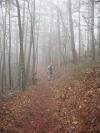

| Online: | |
| Visits: | |
| Stories: |

| Story Views | |
| Now: | |
| Last Hour: | |
| Last 24 Hours: | |
| Total: | |
Park Limits Access in Whiteoak Sink Area to Protect Declining Bat Populations
Great Smoky Mountains National Park officials will reopen the Whiteoak Sink area with limited access effective April 1 through May 15 to limit human disturbance in critical bat habitat and help hikers avoid interactions with bats. Park biologists will continue monitoring bat populations near the site as they emerge from winter hibernacula to collect population, ecological, and behavioral data that will provide resource managers information to develop a long-term protection plan.
The Whiteoak Sink area is primarily accessed from the Schoolhouse Gap Trail between Townsend and Cades Cove. Hikers may descend into the Whiteoak Sink area, but access to the waterfall and additional areas are closed. The closed areas are clearly marked by orange fencing or signs. Hikers may not hike beyond the restricted areas.
“The Whiteoak Sink area provides critical wintering habitats for bats,” said Park Superintendent Cassius Cash. “We ask that everyone respect these closures in order to minimize disturbance to declining bat populations as they emerge from hibernation.”
Biologists continue to see dramatic declines in cave-dwelling bat populations in the park due to white-nose syndrome (WNS). Bat researchers from Indiana State University have been monitoring summer bat populations since 2009 and documented declines ranging from 87% for tri-colored bats to 100% for little brown bats using mist-net surveys. Historically, these species were two of the most common in the park. Since 2013, researchers surveyed primary bat caves in the park and documented a 92% decline for the endangered Indiana bat. Surveys of secondary bat caves documented an 82.7% to 94.6% overall population decline for all cave-dwelling bats.
Infected bats are marked by a white fungal growth on their noses, wings, and tail membrane. The skin irritation damages skin tissue causing the bats to wake from hibernation during winter months. Once aroused, the bats burn energy at a much faster rate depleting stored fat. With no food source available during the winter, the bats soon die. Infected bats exhibit unusual behavior including flying erratically during the day, even during winter months, and diving down toward people. They may be seen flopping around on the ground around cave openings.
The park is home to 13 species of bats including the recently discovered Gray bat, the federally endangered Indiana bat, and the federally threatened northern long-eared bat which was added to the list in February due to declines caused by WNS . Bats play a significant role in maintaining ecological balance as the primary predators of night-flying insects. Biologists estimate that an individual bat can eat between 3,000 to 6,000 insects each night including moths, beetles, and mosquitoes.
Great Smoky Mountains National Park is cooperatively working with other parks and federal, local and state agencies across the country to protect bats and manage their habitats. In an effort to prevent the unintentional spread of WNS by people, the park closed all of its 16 caves and two mine complexes to public entry in 2009. Ongoing research in the Smokies includes monitoring bat populations in the winter during hibernation and tracking bats in the summer to determine habitat use. A plan released by the U.S. Fish & Wildlife Service aimed at stabilizing the dramatic decline of the Indiana bat identified hibernacula found in the Smokies as one of only 13 sites across the country identified as critical habitat for this endangered bat. Wildlife biologists have determined that giving the bats the chance to survive includes establishing protective zones surrounding critical habitat caves.
Humans are not susceptible to WNS because the fungus requires a cold body temperature to survive, but skin-to-skin contact with bats should be avoided due to other transmittable diseases such as rabies. Bats are the only mammal species in the park that have tested positive for rabies. According to the Centers for Disease Control and Prevention, the transmission of rabies virus can occur from minor, seemingly unimportant, or unrecognized bites from bats. For human safety, it is important not to touch or handle a bat. The Department of Health and Human Services recommends that individuals should seek immediate medical attention if they have had skin-to-skin exposure to a bat.
For more information about bats, please the park website at http://www.nps.gov/grsm/naturescience/caves.htm.
Jeff
HikingintheSmokys.com
HikinginGlacier.com
RockyMountainHikingTrails.com
TetonHikingTrails.com The Smoky Mountain Hiker is the author of the Smoky Mountain Hiking Blog and the online trail guide, HikingintheSmokys.com
http://hikinginthesmokys.blogspot.com/
http://www.hikinginthesmokys.com/
Source: http://hikinginthesmokys.blogspot.com/2017/03/park-limits-access-in-whiteoak-sink.html


